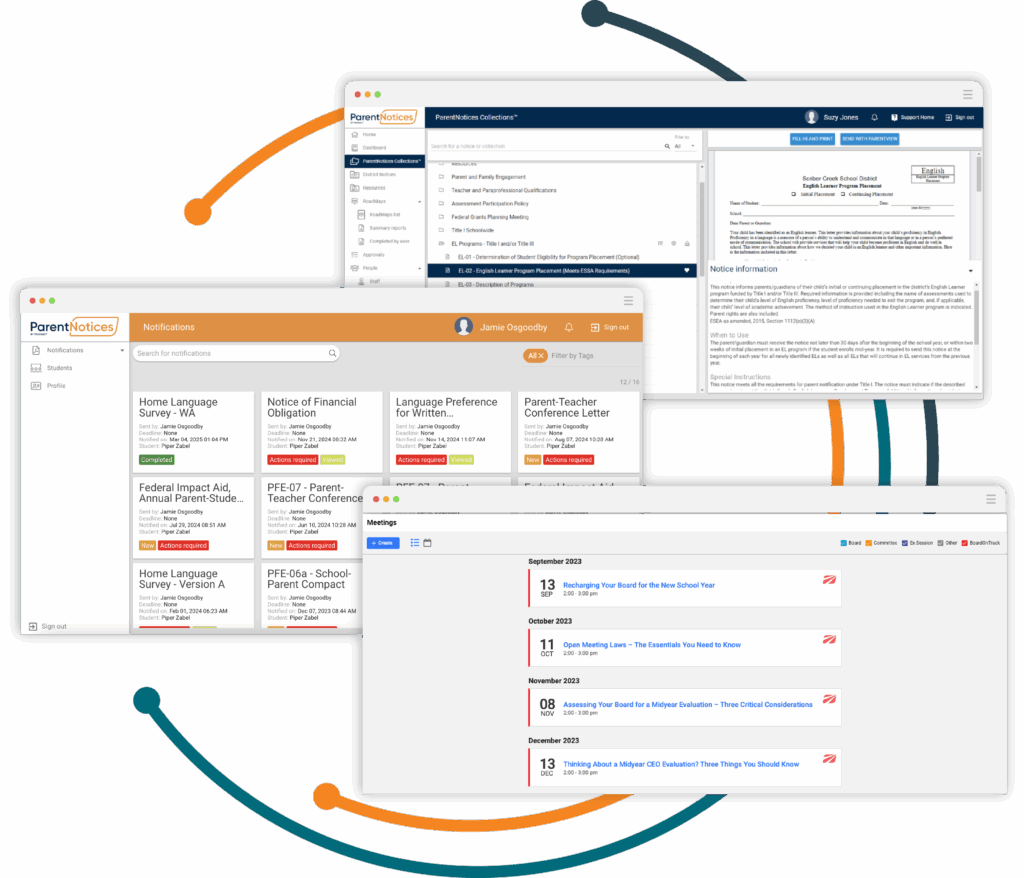Federal Programs Compliance Made Simple
Built by former federal programs directors who understand the complexity of ESSA, Title I and III requirements, federal reporting, McKinney-Vento programs, and parent engagement communication compliance.
Key Solutions
- Parent Notices: Automated ESSA and Civil Rights communication compliance plus professional notification translations in 25+ languages
- Board on Track: Complete board governance and meeting management
- After School 21: Comprehensive management of 21CCLC-funded after school programs and streamlined 21APR reporting

Proven Compliance at Every Level
When monitoring visits loom, compliance deadlines approach, program management seems overwhelming, or translation requirements impact your budget, you need solutions that actually make meeting federal program guidelines easier. Our comprehensive solutions streamline everything from ESSA and Civil Rights compliance to board governance so you can focus on serving students rather than managing paperwork.
- Translated parent communications to ensure ESSA, Civil Rights, IDEA, and Section 504 compliance — fully aligned with federal requirements
- OST and 21CCLC-funded after-school program management to unify online enrollment, attendance tracking, and data management, and help you more effectively and efficiently showcase your program’s impact
- Advanced case management to support at-risk student populations such as McKinney-Vento eligible students
- Trusted by districts and State Boards of Education across the country to enhance student support and streamline compliance workflows


Open Meeting Law Compliance
- Automated alert to ensure agenda posting meets state-specific timing requirements
- Public notification systems that ensure proper community access
- Secure documentation with built-in audit trails for transparency
- Compliance tracking that flags potential issues before they become problems

ESSA & Civil Rights Communication Compliance
The Challenge
The Solution
300+ professionally translated, legally reviewed forms in 25+ languages with automated delivery and compliance tracking.
- Pre-written forms for Title I, Civil Rights, IDEA, Section 504, and McKinney-Vento requirements
- Professional translations that meet federal language access standards
- Digital signatures and delivery confirmation for documentation
- Mobile-friendly family access in preferred languages
- Automated compliance reporting for federal monitoring
Board Governance
From board meetings to strategic leadership — tools that transform governance
For Individual Boards
Complete meeting management, strategic planning frameworks, and performance tracking that keeps boards focused on their mission — positive student outcomes.
For Multi-Board Organizations
Portfolio oversight across multiple boards with centralized document control, brand consistency, and coordinated governance standards.
BoardOnTrack™ Coaching Included
Expert guidance from experienced educational leaders who understand charter school and district governance challenges.
What's Inside:
- Meeting scheduling, agenda creation, and document management
- Strategic planning tools with goal tracking and progress measurement
- Senior leader evaluation tools to ensure consistent, data-based evaluations
- Trustee recruitment support with data-driven selection tools
- Role-based security ensuring appropriate access controls
- Performance dashboards for board effectiveness measurement

Built for Real-World Compliance
Ready to Simplify Your Compliance & Governance?
Let's discuss how Pathwise can help you maintain compliance, improve governance, and free you to focus on student success.